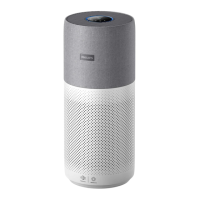6 EN
•
If you want to connect more than one air purier to your smartphone or tablet, you have to do this
one by one.
•
Make sure that the distance between your smartphone or tablet and the air purier is less than 10 m
without any obstructions.
•
This App supports the latest versions of Android and iOS. Please check www.philips.com/cleanhome
for the latest update of supported operating systems and devices.
Note:
•
Reset the Wi-Fi connection when your default network has changed.
1 Put the plug of the air purier in the power socket and touch to turn on the air purier.
2 Touch and simultaneously for 3 seconds until you hear a beep.
» The air purier goes to pairing mode.
» The Wi-Fi indicator blinks orange.
3 Follow the steps 3-4 in section.
4 Using the air purifier
Understanding the air quality light
The air quality light automatically goes on when the
air purier is switched on, and lights up all colors
in sequence. After approximately 30 seconds, the
particle sensor selects the color that corresponds to
the surrounding air quality of airborne particles.
The color of the air quality light is determined
by the highest index among PM2.5, IAI and Gas
readings.
IAI
The professional-grade AeraSense sensor detects the level
of indoor air allergen and with numerical feedback from 1
to 12 the potential risk level of indoor air allergens can be
displayed. 1 indicates best air quality.
AeraSense sensing technology accurately detects and
quickly responds to even the slightest particle
change in the air. It provides you with reassurance
with real-time PM2.5 feedback.
Most of the indoor air pollutants fall under PM2.5 –
which refers to airborne particle pollutants smaller
than 2.5 micrometers. Common indoor sources of
ne particles are tobacco smoke, cooking, burning
candles. Some airborne bacteria and the smallest
mold spores, pet allergen and dust mite allergen
particles also fall under PM2.5.
Air quality light color Air quality level
Blue Good
Blue-purple Fair
Purple-red Poor
Red Very poor
IAI level Air quality light color
1-3 Blue
4-6 Blue-purple
7-9 Purple-red
10-12 Red
Air quality light color
≤12 Blue
13-35 Blue-purple
36-55 Purple-red
>55 Red

